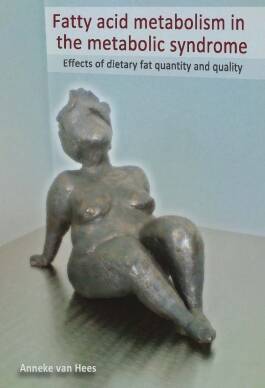Thesis Anneke van Hees

FATTY ACID METABOLISM IN THE METABOLIC SYNDROME
Effects of dietary fat quantity an quality
The metabolic syndrome (MetS) is a heterogeneous condition that is characterised
by abdominal obesity, hyperglycaemia, insulin resistance, dyslipidaemia and
hypertension, which markedly enhance the risk for the development of
cardiovascular diseases and type 2 diabetes mellitus. Disturbances in fatty acid
metabolism play an important role in the MetS. During conditions of chronic
excessive energy intake (a high-fat, energy dense diet) and a sedentary lifestyle, the
adipose tissue expands and its capacity to adequately store dietary lipids becomes
limited. As a result, lipids ‘flow over’ into the circulation and non-adipose tissues
such as skeletal muscle, liver, heart and pancreas are exposed to an excessive
supply of triacylglycerol (TAG) and free fatty acids (FFA). Both the increased supply
of lipids to skeletal muscle and intrinsic disturbances in skeletal muscle fatty acid
metabolism may contribute to intramyocellular lipid accumulation and the
development of insulin resistance in skeletal muscle. Dietary intervention, aimed at
reducing the intake of saturated fat, may improve lipid metabolism and insulin
action in the MetS. The research described in this thesis was mainly performed as
part of the LIPGENE human dietary intervention study; a 12-week European multicentre study designed to investigate the effects of reducing dietary saturated fat by isoenergetic alteration of fat quantity and quality on insulin sensitivity and various risk factors of the MetS.
Anneke van Hees, November 11th 2011

